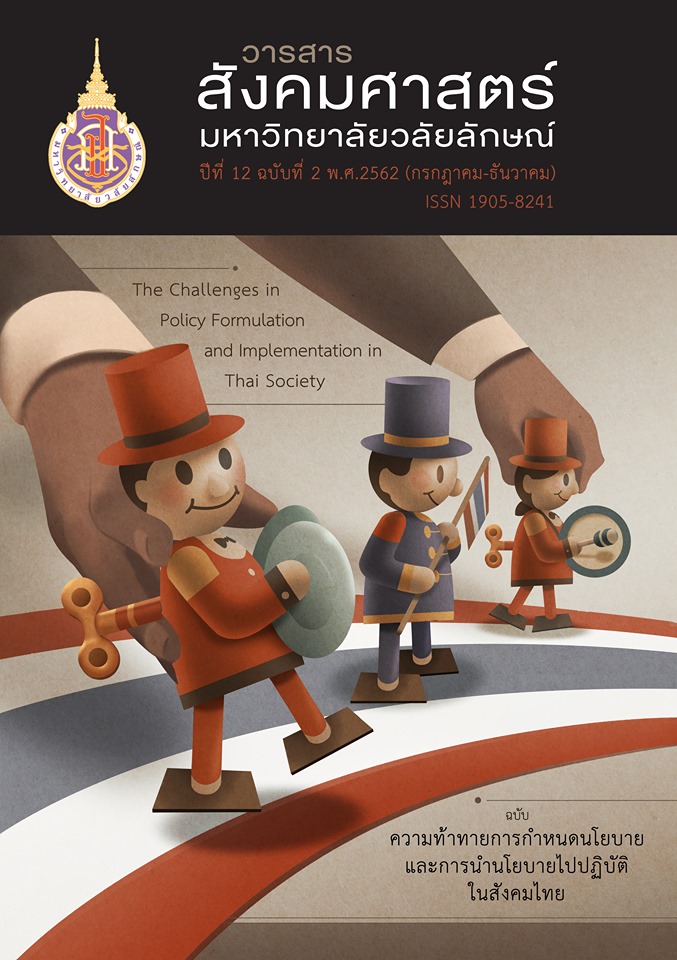The Analysis of Corruption in Transnational Migrant Workers’ Brokerage Networks within the Thai Seafood Processing Industry: A Case of Recruitment Agency through Memorandum of Understanding between the Governments in the Employment of Workers (MOU)
Main Article Content
Abstract
The research objectives were 1) to analyze characteristics of transnational brokerage networks and types of corruption within the Thai seafood processing industry, a case study of authorized employment companies in the category of MoU, and 2) to synthesize for measures to solve and combat corruption within the Thai seafood processing industry. Data collection was conducted via semi-structure and focus group interviews, observation, and reliable secondary data analysis. Population included 113 samples of Myanmar migrant workers, who had migrated to work or currently work in Samut Sakhon and Songkhla areas in the seafood processing industry, individual agents, recruiting companies of Thailand and Myanmar, employers and relevant stakeholders in the field. Data was collected between June and October 2018. Findings showed that characteristics and types of corruption regarding authorized employment agencies or recruiting companies were petty corruption and gray corruption. The corrupting techniques included proving fake information to workers, overcharging fees exceeding the law permitted rate, and bribing some officials. Reasons for existence of corruption and of brokers were 1) the high payment or profit to relevant groups, 2) the existence and acceptance of the patron-client system and of viewpoints considering some types of corruption as normal, and 3) the migrant workers’ unawareness towards the recruitment procedures. The recommendations include the need to promote cooperation between Thailand and Myanmar concerning migrant workers’ employment, to instill good moral and values, to duly penalize the wrongdoers as a way to stop others from imitating the acts, and to provide migrant workers with a proper training before departure to avoid the exploitation from illicit brokers.
Article Details
Copyright: CC BY-NC-ND 4.0
References
Chantavanich, S., Vungsiriphisal, P., & Laodumrongchai, S. (2007). Thailand policies towards migrant workers from Myanmar. Bangkok: Asian Research Centre for Migration, Chulalongkorn University.
Chintayananda, S., Risser, G., & Chantavanich, S. (1997). The monitoring of the registration of immigrant workers from Myanmar, Cambodia, and Laos in Thailand. Bangkok: Institute of Asian Studies, Chulalongkorn University.
Dahlström, C., & Lapuente, V. (2012). Weberian bureaucracy and corruption prevention. Department of Political Science, University of Gothenburg. Retrieved from https://unpan1.un.org/intradoc/groups/public/documents/un-dpadm/unpan049621.pdf
Foreign workers Administration Office. (2018a). rāi chư̄ bō̜risat thī dai rap bai ʻanuyāt nam khon tāngdāo mā tham ngān kap nāičhāng nai prathēt. [List of companies receiving the permitted license to import migrant workers to work with employers in Thailand].Retrieved from https://www.doe.go.th/prd/assets/upload/files/ipd_th/ff6f79 aa053ca527a7749151ebf9f9d7.pdf
Foreign workers Administration Office. (2018b). rāi chư̄ bō̜risat mīa nō̜mā thī dai rap ʻanuyāt hai song ʻō̜krǣng ngān mīa nō̜mā māyang prathēt Thai. [List of authorized Myanmar companies to export Myanmar workers to Thailand]. Retrieved from https://www.doe.go.th/prd/assets/upload/files/alien_th/cd9df4ca690560faa48efdc2a740b0a4.pdf
Guardian. (2014). Modern-day slavery in focus Thailand accused of failing to stamp out murder and slavery in fishing industry. Retrieved from https://www.theguardian.com/ global-development/2017/mar/30/thailand-failing-to-stamp-out-murder-slavery-fishing-industry-starvation-forced-labour-trafficking
Jain, K.A. (2011). Corruption. Retrieved from https://www.ifo.de/DocDL/dicereport211-forum1.pdf
King Prajadhipok's Institute. (2015). ʻēkkasān sangkhro̜ ngān wichākān klum hūakhō̜ kānphatthanā māttrakān pō̜ngkan læ prāpprām kān thutčharit nai phāk rat yāng pen rūppatham. [Synthesizing document of an academic unit in the topic of development of preventive measures and concrete corruption suppression in government sectors]. Bangkok: King Prajadhipok's Institute.
Khoman, S., Tantivasadakarn, C., & Wrasai, P. (2009.) Comparative study of anti-corruption measures and procedures in selected APEC economies. Singapore: APEC Secretariat.
Labour Rights Promotion Network Foundation (LPN). (2011). Raiding abusive workplaces: making a strong case on trafficking and forced labour. Thailand: LPN Foundation.
Markcharoen, P. (2010). Subcontracting arrangements in small-plants fish-processing and their Impacts on child labor: A case study of Samut Sakhon province. Bangkok: Asian Research Centre for Migration, Chulalongkorn University.
Migrant Working Group. (2017). Statistics, policies and laws related to migrant. Retrieved from https://mwgthailand.files.wordpress.com/2017/09/migrant-policy-and-law-by-mwg-july-august-17-en.pdf
Minto, A. (2018). The anatomy of corruption practices: A theoretical framework for a macro analysis. International Anti-Corruption Academy. Retrieved from https://www.iaca.int/ images/Research/Research_paper_04_Andrea_ Minto_final.pdf
Morris, D.S. (2011). Forms of corruption. CESifo DICE report. Retrieved from https://www.ifo.de/DocDL/dicereport211-forum2.pdf
Office of National Anti-Corruption Commission. (2009). rūpbǣp kān thutčharit khō̜ng ʻongkō̜n phāk rat thī mungnēn kāndamnœ̄n kān nai chœ̄ng thurakit. [Types of corruption in government sectors focusing on business operation]. Retrieved from https://nacc.go.th/images/research_natthanun/shapter3.pdf
OECD Public Governance Reviews. (2016). Trafficking in persons and corruption: Breaking the chain. Retrieved from https://dx.doi.org/10.1787/9789264253728-en
Office of the National Anti-Corruption Commission. (n.d.). Chapter 3 rūpbǣp kān thutčharit
khō̜ng ʻongkō̜n phāk rat thī mungnēn kāndamnœ̄n kān nai chœ̄ng thurakit. [Corrption types of governmental organizations]. Retrieved from https://nacc.go.th/images/ research_natthanun/shapter3.pdf
Rathamarit, U. (1987). panhā bāng prakān kīeokap phō̜ rō̜ bō̜ pō̜ngkan læ prāpprām kān thutčharit læ praphrưt mi chō̜p nai rātchakān. [Some problems concerning prevention and suppression of corruption in government units act]. Retrieved from https://digi.library.tu.ac.th/thesis/la/0944/01TITLE.pdf
Sakaew, S., & Tangpratchakoon P. (2009). Brokers and labor migration from Myanmar: A case study from Samut Sakhon. Bangkok: Labour Rights Promotion Network.
Schwertheim, H. (2017). Innovations in anti-corruption approaches: A resource guide. International Institute for Democracy and Electoral Assistance. Retrieved from https://www.idea.int/gsod/files/IDEA-GSOD-2017-RESOURCE-GUIDE-ANTI-CORRUPTION.pdf
Sippapaas, N. (2009). Human security on education among migrant children in Samut Sakhon. Bangkok: Asian Research Centre for Migration, Chulalongkorn University.
Šumah, Š. (2018). Corruption, causes and consequences. Retrieved from https://www.researchgate.net/publication/328081475_Corruption_Causes_and _Consequences
Verité. (2013). Corruption and labor trafficking in global supply chains. Retrieved from https://www.verite.org/wp-content/uploads/2016/11/WhitePaperCorruptionLabor Trafficking.pdf.
Win, M.M.H. (2016). Labor Migration in Myanmar. Retrieved from https://www.pic.org.kh/ images/2016Research/20170404%20Myanmar%20 Labour%20Migration_Eng.pdf
Wongboonsin, P. (2009). kān yāi thin : thritsadī læ khwāmpen pai nai ʻĒchīa. [Migration: theories and situations in Asia]. Bangkok: Chulalongkorn University Press.


